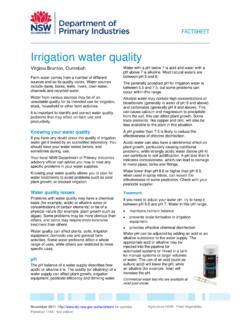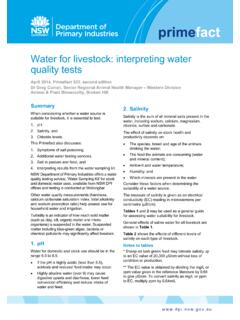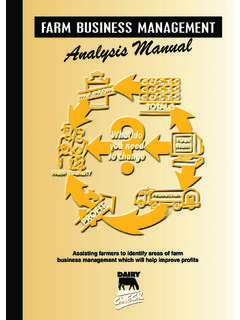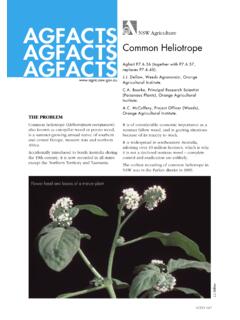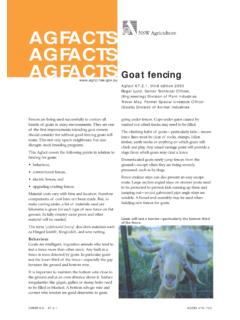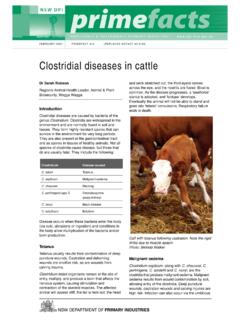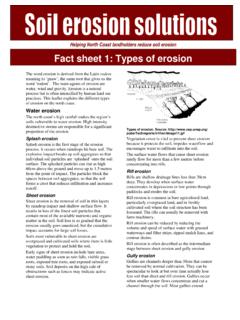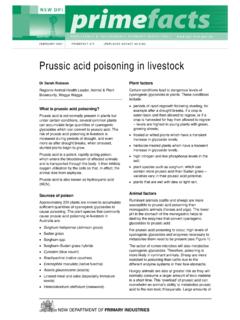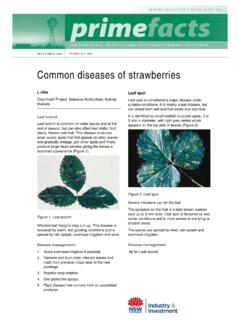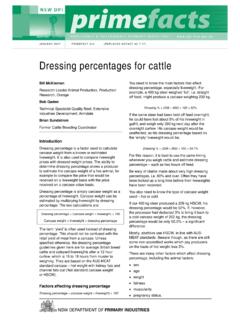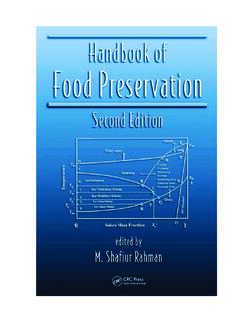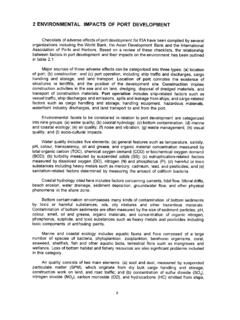Transcription of Aquatic weed management in waterways and dams
1 November 2008 Primefact 30 Replaces Agfact Aquatic weed management in waterways and dams Peter Gorham Many edge plants play an important role in nutrient Noxious Plants Advisory Officer, NSW DPI, Richmond buffering, bank stabilisation and sediment trapping. Oxygen is the single most important water quality parameter and submerged plants help to oxygenate Introduction the water. Aquatic plants serve a variety of uses in a water Aquatic plants also play an important role in providing system, some of which are vital to the overall health habitat for many organisms, particularly birds, amphibians, fish and many insects and other small of the Aquatic environment. There are numerous pond creatures. Floating plants give shade, reduce Aquatic plants that grow in farm dams , streams and evaporation rates and keep the water temperature waterways and fortunately most are rarely a problem. more constant. However, when water becomes rich in nutrients Aquatic plants can grow vigorously to a point where In many cases a water body is a diverse and they become a nuisance or are considered a weed .
2 Balanced ecosystem and care needs to be taken to keep this balance at an advantage. Excess growth This information is intended for both property owners may indicate an imbalance and lead to a deterioration and officers of public authorities. of the ecosystem. Aquatic plants should only be controlled when Aquatic plants become a problem when they: they interfere with the use of a particular Aquatic Blanket the entire water surface, causing oxygen environment or when there is a statutory obligation depletion this may destroy the under-surface (see Legislation'). ecosystem and kill Aquatic species (Figure 2);. An assessment of the plant's ecology and the As introduced species, compete with native problem it poses are necessary before taking any species and reduce biodiversity;. action, to ensure that the most cost-effective and Impact on the Aquatic habitat of bird species and environmentally sound control techniques are used. cause them to relocate;. When managing the problem several factors need Interfere with commercial and recreational activities.
3 To be considered. These include the source of the Cause blockages or impede water intake to plant, the reason it poses a problem, the use made pumping equipment mesh cages may have to be of the waterway ( dam supplying irrigation or made to house the foot valve away from the weed . stock water), the management options available, and ongoing costs and benefits. It may be possible to reduce or eliminate an Aquatic weed through well planned management strategies, such as diverting inflow of nutrients. The weed problem may also be seasonal and naturally fluctuate and disappear over time. Often the best option for controlling Aquatic plants is to take the necessary actions described in this Primefact to prevent the problem from occurring in the first place (Figure 1). Impact Some Aquatic plants fulfil many beneficial functions and play a vital role in Aquatic environments. Figure 1. Take action in the early growth stage to prevent Removal of these plants may result in destroying the problem getting out of hand.
4 Photo: P. gorham. water quality and habitat with no real benefit. problem worse. To prevent a recurrence of the problem, you must be prepared to manage the water body and its surrounds well into the future. It is also best to use an integrated approach when managing Aquatic weeds. Individual control methods used in isolation rarely provide adequate long-term control. Integrated management combines two or more techniques in a unified program. An integrated program usually provides more efficient and stable control in the long term with fewer undesirable side effects. The advantage of integrated management is that it maximises the benefits of the methods and minimises their limitations. Figure 2. Total cover of a water body by water lettuce. Following is a step-by-step example of integrated Photo: P. gorham. control of weeds in a small dam. Contaminate and taint drinking water supplies; 1. Mechanically or physically remove plants when they first appear. Cause pungent odours.
5 2. Treat any remnants with spot applications of a Accumulate debris;. recommended herbicide. Impede the access of stock to water;. 3. If practical, take advantage of dry periods by Interfere with flow in irrigation channels; dredging the dam to deepen it. Deeper water Increase transpiration rates. discourages growth of plants rooted in the bottom by limiting sunlight penetration. Managing Aquatic weeds 4. Divert nutrient run off away from the dam as nutrient A successful weed control program depends on the rich waters encourage Aquatic weed growth. resources available, the weeds present and the ability 5. Plant trees to shade the dam and therefore, as with to carry out effective control methods. The decision- dredging, reduce available light to the plant. making process, with regard to managing Aquatic weeds, needs to follow a number of steps. 6. Use biological control agents if they are available and are suitable to the particular situation. Determining the cause of the problem will allow the 7.
6 Strategic placement of barriers or booms to contain selection of the best management techniques to the weeds and to prevent them from spreading can address the problem. Consider a number of other be highly effective. factors. Do you need to get rid of the plant entirely, or only partially? 8. Continual monitoring of the site is necessary. Some plants may grow prolifically in some seasons Identification of the plant but not in others and are therefore only a short- To select the most appropriate management option, term nuisance. Others may proliferate because of it is essential that the plant is correctly identified. In temporary conditions, such as low water levels due most situations, several species of Aquatic plants are to drought, but in normal circumstances are less present. If one problem species is removed this might problematic. lead to the proliferation of other less desirable species. If a weed is covering a dam and preventing stock from There are a number of books and advisory watering you may think the weed is the problem, but services available to identify plants, and a list of look at what is causing the weed to grow.
7 Nutrient websites can be found at Royal Botanic Gardens runoff and lack of shading around the dam may be website If the allowing the weed to expand due to high nutrient plant is declared noxious you are required by law to levels and sunlight exposure. In this case treat control it. However it may be the opposite a rare or the cause of the problem, by preventing nutrient threatened species you are lucky to have. rich runoff going into the dam plant appropriate vegetation around the dam. The most common Aquatic plants can be divided into four groups depending on how and where they grow. If Aquatic weed growth is depleting oxygen levels in the water and causing fish to die it may be appropriate 1. Free floating plants to treat the weed . However, using control techniques These plants float on the water surface with their roots that leave dead and decaying plants in the water gaining nutrients directly from the water. Native free can also cause deoxygenation of the water. Large floating plants include Azolla species and duckweeds amounts of decomposing plant material lower the including Lemna species, Wolffia species and Spirodela dissolved oxygen levels in the water affecting fish and species.
8 Some free floating plants that are declared other Aquatic organisms. noxious weeds include the introduced salvinia (Salvinia Consider the long-term consequences of any control molesta), water hyacinth (Eichhornia crassipes) and method. Using the wrong method could make the water lettuce (Pistia stratiotes) (Figure 3). 2 primefact 30, Aquatic weed management 2. Floating attached plants Aquatic plant reproduction These plants are rooted into silt at the bottom of the Once you have identified the Aquatic plant species, water body, but with some or all leaves floating on knowledge of its reproductive mechanisms will also the surface. Examples include waterlilies (Nymphaea assist with determining the best management technique. species) (Figure 4) and the noxious weed alligator Not all Aquatic plants produce viable seed but spread weed (Alternanthera philoxeroides) (this may also and multiply from fragments of stem, root or leaves. grow on land). Examples include salvinia and alligator weed .
9 Other Aquatic weeds produce seed and are also able to 3. Submerged plants propagate from stem, root or leaf fragments. Examples These plants live completely under the water, although include water hyacinth and water lettuce. their flowers may float on the surface. They include When planning a weed management program the native ribbon weed (Vallisneria americana) for aquatics weeds, managers must decide what and the introduced elodea (Elodea canadensis), is possible or necessary. For Aquatic weeds that dense waterweed (Egeria densa) and water milfoils reproduce by fragments, every piece of plant material (Myriophyllum species). Cabomba (Cabomba must be removed or killed. This requires intensive caroliniana) is a submerged plant that is declared follow up control until there is no presence of the weed noxious (Figure 5). at all. For plants that produce seed, control must be carried out until the soil seed bank is exhausted (this 4. Emergent plants may take many years). In some situations some level These plants are rooted in shallow water, around the of weed presence can be tolerated and management edges of water or in damp situations.
10 Their stems should consist of controlling priority areas or keeping and leaves appear above the water surface. Plants in the presence of the weed at suppressed levels. this group include the rushes (Figure 6). This group Aquatic weed management techniques also includes a number of noxious weeds that have been introduced, such as Ludwigia peruviana, L. Prevention longifolia, Hygrophila costata (Figure 7), Senegal The best option for controlling Aquatic plants in a body tea (Gymnocoronis spilanthoides) and horsetails of water is to take the necessary steps to prevent the (Equisetum species). problem from occurring. It is easier and more cost Figure 3. Water lettuce, a free floating plant. Figure 5. cabomba, a submerged plant. Photo: P. gorham. Photo: P. gorham. Figure 4. Waterlilies, a floating attached plant. Figure 6. Juncus acutus, a type of rush, is an emerged Photo: P. gorham. plant. Photo: P. gorham. primefact 30, Aquatic weed management 3. Maintenance control Maintenance control is a system of not allowing water courses, dams or any water body to become completely covered with Aquatic weeds.
